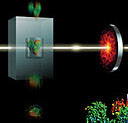

Friday - March 6, 2009
SLAC Today is
available online at:
http://today.slac.stanford.edu
In this issue:
From the Director: Good News and Bad News
Spring Forward This Weekend
Word of the Week: Hard X-rays
 |
 |
|
Friday - March 6, 2009 |
From the Director: Good News and Bad News This has been a week of good news and bad news. While we in lab management do not yet know what funding SLAC will receive from the stimulus package, all indications are very positive that both our scientific programs and our site infrastructure will benefit significantly. I believe this will present great opportunities to position the lab for its future, and I look forward to sharing more details with you as we learn them in the coming weeks. While we do not yet know our fiscal year 2009 funding level, I remain quite optimistic about the eventual budget appropriations for this year. However, there was bad news this week as well. Due to the University’s need to take deeper budget cuts than originally planned, the president and provost have announced that there will be no general salary increases for either faculty or staff in FY10. This, of course, includes us. We had all hoped to retain at least a small salary program. However, that will not be possible in FY10. Read more... Spring Forward This WeekendThis Sunday, 2:00 a.m. PST will skip forward to become 3:00 a.m. PDT in the U.S. with the start of Daylight Savings Time 2009. Remember to set your clocks one hour ahead this weekend. Word of the Week: Hard X‑rays The Linac Coherent Light Source will produce ultrafast pulses of X-rays millions of times brighter than
previous sources—pulses powerful enough to make images of single molecules.
X-rays are high-energy ripples of electromagnetic radiation, which spring into existence when charged particles change speed or direction. But not all X-rays are created equal. The electromagnetic spectrum is broken up by wavelength (the distance between the ripples' peaks), which is related to energy. X-rays inhabit the portion of the spectrum that runs from one-tenth of an angstrom—about the size of an atom—to 100 angstroms. The X-ray band is subdivided further, into hard X-rays and soft X-rays. Hard X-rays are "hard" because they have short wavelengths, between about one and 20 angstroms, and high energies. This allows them to penetrate further into materials than lower-energy soft X-rays. SLAC's Linac Coherent Light Source will be the first free-electron laser in the world to produce hard X-rays. The X-rays' short wavelength—atom-sized or smaller—will allow physicists to take pictures of atoms and molecules in action, as well as probe unusual states of matter. |
Events
Access (see all)Announcements
|
|
| | ||
|
|
||
 <%
Response.AddHeader "Last-modified", getArticleDate()
'Response.AddHeader "Last-modified","Mon, 01 Sep 1997 01:03:33 GMT"
'Monday, December 06, 2010
%>
<%
Response.AddHeader "Last-modified", getArticleDate()
'Response.AddHeader "Last-modified","Mon, 01 Sep 1997 01:03:33 GMT"
'Monday, December 06, 2010
%>View online at http://today.slac.stanford.edu/. |
||